Many destination ideas just somehow find their way to us. After having watched "Pékin Express" TV show on the French TV in winter 2022 (I think this show is called the Amazing Race in English), where a part of it was filmed in Jordan, we added Jordan to our travel bucket list. One day we will go there, we said... And then in June we started thinking about the October holidays - somewhere not too far, where the weather is still nice, lots of things to see and do - maybe we could go to Jordan sooner than we expected. As I have already said in this blog, there is a Ryanair base with lots of destinations to choose from two hours from us, in Marseille. It took a bit of combining and I found return tickets to Amman for the four of us with only a bit over 900 euros with Ryanair Family Plus (that includes luggage and seat selection). That meant staying a night in Paphos, Cyprus on the way there and two nights in Bucharest, Romania on the way back. Adventurous like we are, we did not mind these little detours at all.
Jordan is a realtively small country, but it has a lot to offer, so we decided to have a pretty full itinerary for the nine days we were going to spend there. The easiest way to get around is by car and we rented one on the day we left Amman (there was no need for the car in the city). We also bought our Jordan Passes a couple of weeks before the trip - Jordan Pass combines the visa, enrtrance to Petra and many other site entrances. The price of the pass depends on how many days is the Petra visit for - we took the pass with one day at Petra and paid 99 USD (70 JOD) per person. It is a good deal and I definitely recommend it, as the visa alone costs already 40 JOD and Petra ticket for one day is 50 JOD. All the planning done, we were counting the days to be able to start our next adventure.
The flight from Marseille to Paphos took three and a half hours. We arrived pretty late in the evening (8 pm) and our flight from Paphos to Amman was leaving early the next morning, so I had rented a simple apartment close to the center. The weather in the evening was still warm and pleasant and we went for a walk and dinner in the center. We found a small local family restaurant (well rated in Google) and had a delicious dinner of local specialities on the restaurant's outdoor terrace. Paphos had a nice holiday destination feel to it, and I hope we will have a chance to discover Cyprus a bit more in the future. The taxi was picking us up at 4.30 in the morning for our 6.30 flight to Amman, so the night was going to be very short.
We had an early start the next morning and the 1-hour flight from Paphos to Amman went smoothly. It took some time to get out of the airport though - first the queue to check our Jordan passes (and for those who did not have it, to buy a visa), then another queue to have our passports checked and stamped. As we had arrived early and knew that our hotel room would probably not be available yet, we decided to take the bus from the airport to city center. The bus is the cheapest option to get to the center - 2.5 JOD per person and it is also pretty slow, taking about an hour and a half. It started to rain while we were on the bus - pretty rare for a desert country. Before taking the bus we needed to exchange some local currency. Jordanian Dinar (JOD) was more expensive than euro, 100 euros made about 70 JOD.
Sunrise over the desert landscape of Jordan
We had chosen to stay in the hotel close to the center and Rainbow street - the House Boutique Suites. We took a taxi from the bus station to the hotel and although we arrived early, our room was ready after about 15 minutes of waiting, and having a refreshing juice on the comfy sofas of the reception. We were really happy with our two bedroom, two bathroom suite - the moment we got in our room we all decided to go to bed in order to make up for the previous short night. The hotel was exeptional with excellent service, spacious room and very good breakfast with both local and international choices. I also appreciated a laundry room with washing machines and dryes available for guests to use free of charge and the kids liked the gym. Our beautiful suite in the House Boutique Suites
View of the city from living room window
We woke up from out nap around 12 at noon and felt we were ready to discover the city. Rainbow street was only about a block from our hotel, so that was where we headed first. We stopped at a little cafe to have a bite to eat before discovering further.
A quick bite before heading to town
Amman is an interesting city - it is built on the hills, so you are almost always walking either up or down a hill (there are stairs at steeper places, to make it a little easier; I guess) so the distances can take a bit longer to cover than it looks on the map. Amman, with its population a bit over 4 million, is the largest city in Jordan and the fifth largest city in the Arab world. The earliest evidence of settlement in Amman dates to the 8th millennium BC, and it has been continuously inhabited since then, making it one of the oldest cities in the world. We took a maze of stairs down from the Rainbow street and arrived in the middle of the street market - the souks. It was very busy and pleasantly messy, walking around the array of sounds and smells of the real Middle Eastern souk. We got some freshly squeezed pomegranate juice from one of the many vendors and took in all that hustle around us. Our special favourite was the fruit and vegetable souk.
With well over 10000 steps done for the day we decided to turn back to the comfort of our hotel. Before getting back, we bought a big takeaway shawarma plate from "the World's Best Shawarma" on Rainbow street (the ones of our group who ate it can guarantee it was the best they have ever had). The kids decided to call it a day after a gym session at the hotel, but Johnny and I still had energy to go for another walk at the Rainbow street by night.

The breakfast in the hotel consisted of lots of local foods together with the usual international choices. For those who eat plant based, there was always hummus, mutabal and falafels with veggies and local fresh flatbread - I was pretty excited about it at first, but it quickly became pretty repetitive during the trip. Plant milk cappuccinos were only available in bigger hotels. Otherwise there was lots of local cheese - different types of feta and halloumi like cheeses seemed to be the staple at every breakfast. Jordanians seem to have very sweet tooth, halwa and the pastries were usually extremely sweet.
The plan for the day was to visit the most important landmarks of Amman - the Citadel and the Roman Amphitheatre. The Citadel is located on top of the highest the hill of Amman - 850 m above sea level - so we decided to take a taxi up to the Citadel and walk back down. Occupied since the Bronze Age, the Citadel is surrounded by a 1700m-long wall,
which was rebuilt many times during the Bronze and Iron Ages, as well as
the Roman, Byzantine and Umayyad periods. The ticket of the Citadel in included in the Jordan Pass. There is also a small history museum at the site, that is worth taking a look.
View of the city from the Citadel
It was easy to walk from the Citadel to the Roman Amphitheatre - the street went downhill and the last part before getting to the site was stairs. The 2nd century amphitheatre dates back to the Roman period when the city was known as Philadelphia. The theatre is now used as a venue for cultural activities and musical concerts. The entrance to this site is also free with the Jordan pass.
The stairs on the way from Citadel to Amphitheatre
After the Amphitheatre visit we walked again through the labyrinthe of souks and up the stairs back to the rainbow street and to the hotel. I had broken one of the leather straps of my rucksack and we noticed an interesting ally of many tailors in the souks, so Johnny and I walked back to the souk to see if we could get it repaired. We found a nice tailor who fixed the bag for 2 JOD. All the tailors in the souk were men, also most of the people who worked in the hotel were men, including the housekeepers. The two female waitresses who served breakfast in the hotel were not local, but from the Philippines.
Tailor fixing the bag
As we were leaving Amman the next morning, and international cuisine would have probably been more complicated to find away from the capital, we decided to go to an Italian restaurant that evening. There was a nice looking Italian restaurant called Totti's not far from the hotel and we went to check it out. The food was very good and it came out that the chef was a local lady who had studied Italian cooking in Swizerland. She was very surprised and happy to find someone Italian in her restaurant and treated us with her delicious tiramisu.
Totti's Italian in Amman
We were a bit worried about driving in Amman the next morning, because the traffic that we had experienced in the city so far was very chaotic and busy. Fortunately it was Friday morning - the same as Sunday morning in Europe - and at 9 in the morning there was hardly anyone around. I had a reserved a Nissan Sentra at Dollar car rental and needed to pick it up in the morning to start the drive to Wadi Rum desert. (Un)fortunately they had no medium sized cars available and we got a large Chevrolet instead. The roads were still pretty empty and it was a breeze driving out of Amman to start the four-hour trip on the Desert Highway to Wadi Rum. We are using downloaded offline google maps as a GPS during our travels and so far it has worked out very well everywhere.
We had agreed to meet Mhareb, the owner of the camp called
Wadi Rum Desert Adventures, at Wadi Rum village at 2.30pm. We left our rental car at the parking lot in Wadi Rum village to start our desert tour by jeep and were going to arrive to the camp for sunset. Mhareb introduced us to our guide Ali and we were ready to start our desert adventure.
The unique landscape of Wadi Rum, a protected area and an UNESCO heritage site, has been a filming location for several movies, The Star Wars being probably the most famous of them. There is an entrance fee for the Wadi Rum Protected area, but it is free with the Jordan Pass. It features a varied desert landscape consisting of a range of narrow
gorges, natural arches, towering cliffs, ramps, massive landslides and
caverns. The combination of 25,000 rock carvings with 20,000 inscriptions trace
the evolution of human thought and the early development of the
alphabet. We did a general desert tour, visiting the spring of Lawrence of Arabia, a canyon where rock carvings can be seen, a huge sand dune and an arch, before arriving to our camp. The camp of Mhareb is one of the camps that is farther from the Wadi Rum village, more private, situated next to a beautiful sand dune.There was a big main tent for the meals, a toilet and shower block for all the tents, and several smaller and bigger tents. We were staying in a family tent that had six single beds.
The camp and our tent
Our desert tour
In the evening the dinner was served in the main tent. The meat was slow cooked underground, but there was also a vegetable stew, rice, flatbread and several cold sides like hummus, mutabal, salad. After dinner all the guests were sitting around the fire pit, drinking endless amounts of very sweet sage tea. Mhareb and his team were playing local instruments and singing. We had a really cool mix of people from lots of nationalities in the camp (American, Brasilian, Dutch, British, French...) and everybody ended up dancing around the fire. There is no Wifi or even phone network coverage at the camp, so we were really cut off from the rest of the world and the night sky at the desert without the light pollution was magical. We slept very well in the tent, and after watching the sun rise over the desert, we had a nice breakfast at the main tent before setting off back towards the Wadi Rum village.
Drinking tea before dinner
Camp atmosphere after dinner
Breakfast in the main tent

Our next destination was Aqaba, a resort town by the Red Sea, popular among the tourists but also local people for a seaside weekend break from Amman. Although Jordan has only 27 km of Red Sea coastline, there are several places offering great possibilities for diving and snorkeling. We had heard that the underwater world of the Read Sea was beautiful and wanted to see it ourselves. Although Aqaba was less an hour from Wadi Rum, the climate changed when getting closer to the sea. While in Wadi Rum, it was pretty chilly after the sunset and in the morning. The temperature at Aqaba though, was 30 degrees C and even in the evening it did not go under 20 degrees. Aqaba has a great choice of hotels, from the luxury 5-star resorts to simple guest houses, but the accommodation prices were pretty high. I found a small and pretty recently opened hotel called Twins Boutique Hotel. This hotel had a 3-star ranking, but we found it very nice, clean, with good breakfast and quite spacious family room.
Family room at Twins Boutique Hotel



Aqaba has a nice public beach with a beach promenade and nice little cabanas for a shade but Jordan being a Muslim country, women have to be covered up on the public beaches. In order to sunbathe or stay at the beach with a swimsuit, tourists should go to the private beaches. For the coming day, we had booked the whole day at the Berenice Beach Club - a private beach with swimming pools, sun loungers, changing rooms, several bars and, of course, an amazing beach (Beach Club entrance costed 10 JOD per person). We also reserved a tour with a glass-bottom boat that included visiting the more well known dive sites and reefs and an hour of snorkeling at Japanese Garden. The boat tour was nice, but we would have been ok even not taking it, because at Berenice Beach the coral reef starts about five meters from the shore - the corals were beautiful and there was plenty of colourful fish. We had a great day of beach and snorkel - even managed to see a poisonous scorpion fish.
Berenice Beach Club
Aqaba is a lively town with lots of bars and restaurants. Although there was choice, we ate both nights at the same restaurant, called Khubza & Seneya. They have excellent reviews in both Tripadvisor and Google and we can completely agree - the food was delicious, the service friendly and the prices reasonable.
It was time to travel back inland as we were excited for our upcoming visit to Petra, one of the most well-known UNESCO heritage sites in the world. The drive from Aqaba to Wadi Musa (the closest town to Petra) took a bit over two hours. I had reserved a simple hotel called Esperanza Petra in Wadi Musa. The hotel was a bit further from the town center, but only a couple of hundred meters from the Petra entrance gate. Wadi Musa itself is a touristic town with lots of hotels, restaurants and souvenir shops. Both nights we dined in Wadi Musa, we were really happy with the restaurants and the quality of the food. The restaurants were called Zawaya and Al Wadi. Both had veggie options available in the menu, and the kids could finally taste the local traditional dish called Mansaf - lamb marinated and cooked in yogurt (they did not think it was anything special though).
Landscape around our hotel
We woke up at 5.30 am the morning of the Petra visit. Hotel started serving breakfast at 6, so we ate early and were at Petra gates just a bit after the opening time, at 6.45 (the gates open at 6.30). We had our Jordan Passes scanned and got our Petra tickets. The day ticket costs 50 JOD (around 70 euros), but it is included in Jordan Pass.
Dating to around 300 B.C., Petra was the capital of the Nabatean
Kingdom. Accessed via a narrow canyon called Al Siq, it contains tombs
and temples carved into pink sandstone cliffs, earning its nickname, the
"Rose City". From the entrance there was still about half a kilometer walk to the Siq canyon. The canyon itself is 1.2 km long and it ends in front of the majestic Treasury, probably the most famous site of Petra - we were alrady prepared that we would walk a lot that day.
Early morning at the Siq canyon
Camels in front of Treasury
We decided to do the High Place of Sacrifice path first - most of the visitors probably don't go there, as the path has a lot of stairs to climb and it is pretty long, but it was very beautiful - the views, being only us most of the time, being able to see the lesser known tombs and temples.
The High Place of Sacrifice path
The path ended up at the museums, from where we could start the climb to the Monastery. Many of the local bedouin men tried to sell us a donkey ride up to the Monastery, even saying that there are 1000 steps to get there. Actually there were 780 steps (still a lot!) - Ricardo counted them. The steps were very old, so sometimes uneven but the Monastery was really worth a visit. On the steps there were lots of local people (around 30 families still live in Petra) selling everything from tea and pomegranate juice to souvenirs and carpets. There was a little coffee shop at the Monastery and we had a small picnic there, before taking the same steps back down.
The Monastery and the climb down
Pomegaranate juice break with a view Although we were getting a little bit tired at this point, we did not want to call it a day yet. We still went to do the Royal Tombs path and as a last effort also a climb to see the Treasury from above.
Another break with the view on the way to see the Treasury form above
The Siq canyon seemed a lot longer on our way back to the main entrance of Petra. We were all pretty tired - according to the step tracker I had made a bit over 33900 steps that day that totalled over 22 kms. After a nice hot shower and an early dinner we all went to bed early that evening. We probably did the maximum possible in Petra in one day - we only missed the little Petra. The essentials for a great visit - go early, wear good shoes, bring plenty of water and snacks, take little breaks when tired.
The next day we started moving back north, but we had still planned another couple of stops before it was time to leave Jordan. Our next destination was the famous Dead Sea, the lowest point on Earth (430 meters below sea level). From Wadi Musa it took a bit over three hours to arrive at our next destination - the northern end of the Dead Sea. The route took us through rocky landscape, beautiful views and valleys and the last part followed the coast of the Dead Sea.
After checking out several solutions online before the trip, I realised that the best way to visit the Dead Sea was to stay in one of the resorts. The shores of the Dead Sea are pretty steep and otherwise it would have been complicated to find a place to go in the sea. The Dead Sea resorts are pretty expensive, but I think it was worth the cost.
Hilton Dead Sea was a beautiful hotel with nice spacious rooms (we had connecting double and twin room), several swimming pools, luscious gardens and, of course, excellent facilities for the Dead Sea experience. After the check in, we went straight to enjoy what the Dead Sea had to offer. There was a small artificial sandy beach with sun loungers, showers and instructions on how to take the most of the Dead Sea. The water was extremely salty (do not let it go in the eyes) and it was impossible to sink, but very pleasant to float. We then covered ourselves with mud (it was already in the big ceramic bowls near the showers) - the mud made the skin feel really soft.
Our last day in Jordan started with a delicious long breakfast with the views of the Dead Sea. We still had a couple of places to tick off of our list of what to visit in Jordan and we were going to spend our last evening in Madaba. Madaba is actually situated closer to the airport than Amman and it is called the city of mosaics.
It was not a long drive from the Dead Sea to Madaba, lasting about an hour. The road passed Mount Nebo, a pilgrimage destination since the 4th century. According to the Bible, Moses ascended Mount Nebo, in the land of Moab(today in Jordan), and from there he saw the Promised Land, which God had said he would not enter; Moses then died there. A Christian church from Byzantine times stands on the top of Mount Nebo.The entrance ticket costed 3 JOD per person - that was one of the few places we visited that was not included in the Jordan Pass.
Mosaic floor in the diaconicon-baptistery
We had reserved two rooms in a small B&B in Madaba called Coco Guesthouse - a recently opened place with simple rooms and low price. Madaba is home to the famous 6th century Mosaic Map of Jerusalem and the Holy Land, situated in the Greek Orthodox Church of St. George. It was a nice about 20-minute walk from the B&B to the center. It is a small town and the center is very compact. We did some souvenir shopping, visited a couple of churches and sites, had our last dinner in Jordan and called it an early night.
Mosaic Map of the Holy Land
Our last dinner in Jordan
We had an early start next morning, as our flight to Bucharest was leaving at 9.30. We also had to return our rental car, so we had a quick breakfast at 6.45 and were off to the airport at 7. Madaba is only about 20 minutes from the airport, a lot closer than Amman.
We were very happy to have discovered Jordan - a varied Middle Eastern destination. There is a bit of everything - history, culture, deserts, nature, beach... Jordanian people are very friendly, it is easy to get around by rental car and in about a week to 10 days it is possible to pretty much tour the whole country. Jordan gave us lots of cherished memories and another destination got ticked off of our travel bucket list.
















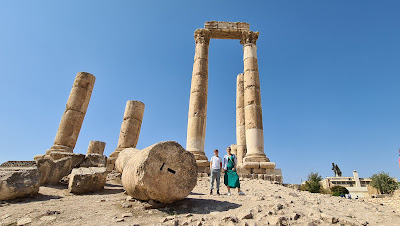




















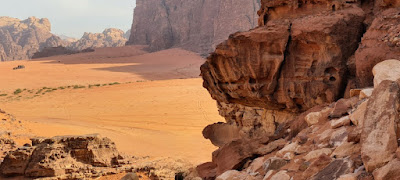








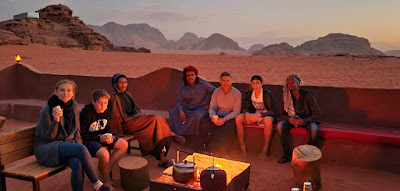












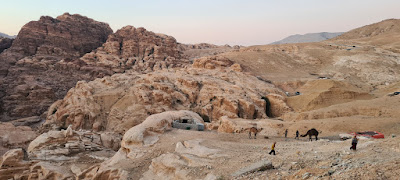







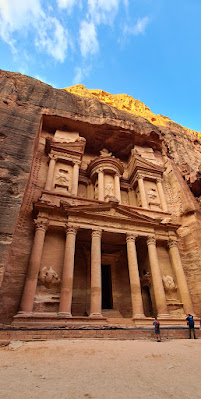


















.jpg)
























No comments:
Post a Comment